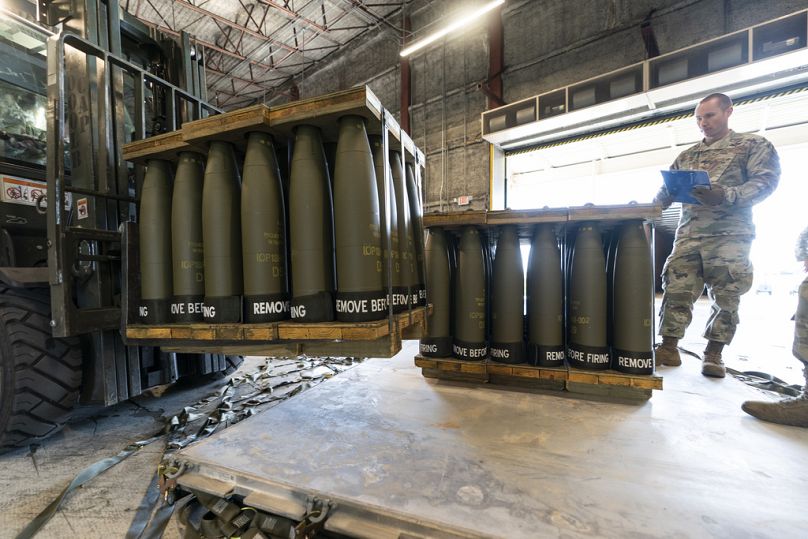It's a complicated situation - made worse still by some American lawmakers calling for a removal of military aid from the war-torn European nation.
The White House has been increasingly pressuring Congress to pass stalled legislation to support Ukraine's war against Russia, saying that funding has run out.
Earlier this week, however, President Joe Biden touted a new military aid package worth $200 million (€183m) for Ukraine.
Money seems to be dwindling - but the announcement of more weapons being sent to Kyiv just underscores the complexity of the funding. So has the money run out? Or are there still a few billion dollars floating around?
It’s complicated.
In a letter to Congress last month, White House budget director Shalanda Young said flatly: “We are out of money to support Ukraine in this fight. This isn’t a next year problem. The time to help a democratic Ukraine fight against Russian aggression is right now.”
Since then, the US has announced three more aid packages totaling $475 million (€434m). That may seem contradictory, but it's due to the complex programmes used to send aid to Ukraine.
There are two pots of money for weapons and security assistance set up specifically for the war. One is the Presidential Drawdown Authority, or PDA, under which the US provides weapons already in its stockpile. The other is the Ukraine Security Assistance Initiative, which funds long-term weapons contracts.
Money for USAI has all been spent. That pot is empty.
The money for the PDA also appeared to be gone, but then the Pentagon determined that it had overstated the value of the weapons it had already sent Ukraine, overcharging the Ukraine weapons account by $6.2 billion (€5.66bn). That effectively left Ukraine with a store credit that is slowly being whittled down. It now stands at around $4.4 billion (€4bn).
PDA packages continued to be announced every few weeks - but, in recognition of the dwindling money, the latest packages have been smaller.
In theory, the Pentagon would have enough equipment to offer smaller packages for months. There is a caveat, though - while the credit exists, there may not be enough stock on the Pentagon shelves, so some weapons may simply be unavailable.
On Thursday, Major General Pat Ryder, the Pentagon press secretary, told reporters the U.S. could provide the full $4.4 billion (€4bn) in weapons, but with only a quarter of that amount available for replenishment, it's a tough choice. “We have to start to make decisions about our own readiness,” he said.
In the US, support for Ukraine funding has been waning as some lawmakers see the war taking funding from domestic needs.
That’s a worry for Ukrainian president Zelenskyy. Earlier this week, he warned in a speech at the National Defence University in Washington that, “If there’s anyone inspired by unresolved issues on Capitol Hill, it’s just Putin and his sick clique.”
Harkening back to the “all politics is local” idea, the Pentagon and the White House have rolled out maps and statistics to show members of Congress how their own districts and states are reaping benefits from the Ukraine funding.
The maps show contracts benefitting industries and companies in more than 35 different states - and US officials are hoping the local jobs argument will help build support for the funding.
Winter has set in, so the fighting in Ukraine has levelled off a little - and along stretches of the battlefront, fighting is somewhat stalemated.
Ukrainian forces have been taking ground back in some key locations, however, and Zelenskyy and other leaders have said they want to keep pushing forward.
Ukraine does not want to give the Russians weeks or months this winter to reset and further solidify their fighting positions - as they did last winter.
During his visit to Washington this week, Zelenskyy said his forces are making progress.
The White House pointed to newly declassified intelligence that shows Ukraine has inflicted heavy losses on Russia in recent fighting around the eastern city of Avdiivka - including 13,000 casualties and over 220 combat vehicles lost.
The Ukrainian holdout in the country’s partly occupied east has been the centre of some of the fiercest fighting in recent weeks.
Putin on Thursday, however, said his troops are making gains.
“Almost all along the line of contact our armed forces, let’s put it modestly, are improving their positions, almost all are in an active stage of action and there is an improvement in the position of our troops all along,” he claimed.












